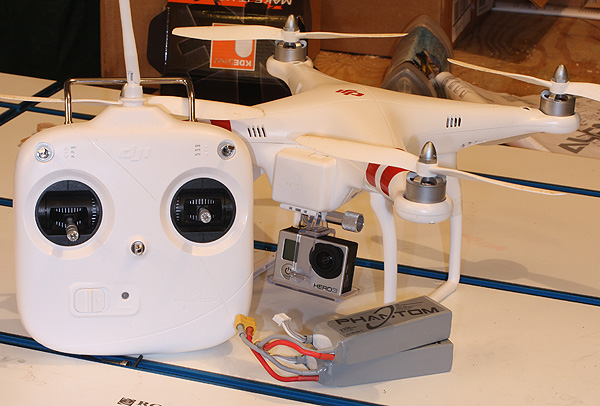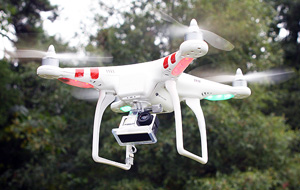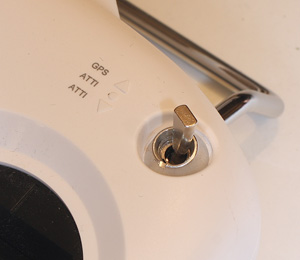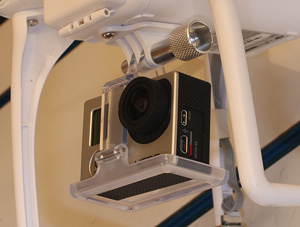



This outfit came with everything you see
here, including an assembled heli.
Text, photos and video by Tom Hintz
Posted - 9-20-2013
One of the really nifty things I discovered on my return to radio control was the development of quadcopters as both a high-tech toy and as a serious camera platform. My interest in the DJI Phantom included both fun and the camera platform thing. Once I read up on the features and technology built into the standard DJI Phantom I had to get one.
The DJI Phantom is a 4-rotor helicopter that measures 350 mm long and wide and 190 mm tall including the hoop-type legs. The all-up weight is about 1000 grams. It has a streamlined body that makes it look faster than its rated top slight speed of 10 meters per second. The DJI Phantom is not a real aerobatic machine with a tilt limit of 45-degrees. Power comes from a 3S, 11.1V 2200 mAh battery pack that is carried within the body.
The DJI Phantom has four motors set in the ends of the four arms. Each motor is fit with a specially designed prop. Two of the props turn clockwise, the other two turn counterclockwise as part of the flight control system. The flight control system varies the RPM of the motors to induce banking, tilting and flight in any direction. The only inverted flight the DJI Phantom is capable of is essentially tripping on a branch on the way up or down and turning over which immediately precedes a big crash. No 3D for this quad – but it does so much more.
Remarkably bright LED’s under each arm of the DJI Phantom body help keep you oriented to the back (green) and front (red). A large LED on the rear of the body gives you various information like the number of GPS satellites it sees, the flight mode and state of the battery charge. (More on that later)

The flight control system works very
well but may need occasional updating
as do many systems.
The DJI Phantom uses an integrated flight dynamics system that combines the Naza-M system and a GPS multi-rotor autopilot system. Add to that a dedicated transmitter (6 channels, 2.4GHZ) that controls the special flight characteristics. All of the complicated stuff is set up at the factory so you can literally fly the DJI Phantom as soon as you charge a battery pack.
The DJI Phantom uses something called the Intelligent Orientation Control (IOC) function of the Naza-M autopilot system. This system,long with the GPS capabilities gives you some unique control options that can make several flying situations easier.
The upper right toggle switch allows you to select GPS or ATTI (attitude mode) flight. The second ATTI position on that switch is for special flight characteristics that have to be enabled through software. Beginner pilots don’t want to accidentally enable that!
Fly the DJI Phantom in the GPS Attitude Mode and along with keeping the craft level it will stop and hold its position when you let go of the control sticks. It is using GPS positioning to determine and hold that position. Once you get the DJI Phantom where you want it you can literally “park it” there. The GPS flight control system will maintain an altitude within .8 of a meter and a position +/- 2.5 meters. In the real world that spread of distances depend on the amount of wind it is fighting to stay there. It really does stay put though and you don’t have to do anything other than stop flying it (in GPS Attitude Mode) and it will stop and stay.
Attitude Mode does not hold a position when you let go of the sticks. It will level the DJI Phantom but any motion you had established will continue. People often use the Attitude Mode when making videos as it is somewhat smoother because the flight control system is not making all the little GPS corrections.

The modes available include ways to
fly the DJI back to you when you lose
orientation.
The upper left toggle switch controls the more exotic flight control modes. Up is Off, the center position engages Course Lock and down turns on Home Lock. Both flight modes require the DJI Phantom to be at least 30 feet away from you.
In Course Lock mode the orientation of the DJI Phantom to you does not matter. When you tell it to go forward it goes away from you, back comes towards you with left and right commands working as expected. The flight control system uses you as the base point and alters the stick commands so the DJI Phantom is much easier to fly when you can’t see it well.
Home Lock mode is much like Course Lock except that left and right stick inputs causes the DJI Phantom to fly on a radian around you. This has some interesting possibilities especially for making videos.
A nifty feature of all of this built in control and GPS capability is that if the DJI Phantom has sufficient GPS information (very common in most places) and it loses communication with the transmitter the DJI Phantom goes to an altitude of 60-feet, flies back to where it started that flight and lands itself if it has sufficient GPS information. If the system does not have enough information to return to the Home point it will simply land where it is when signal is lost.
Part of this system can be initiated if you fly too long and the battery power gets too low. First the led will blink red to warn you of the failing battery. If the power level drops sufficiently the DJI Phantom will automatically land itself to avoid falling out of the sky.
The DJI Phantom comes with a built in mount for the popular GoPro cameras. The camera is hung beneath the DJI Phantom body on a simple but effective tilt mount. I have used the included mount for months with no issues at all. I did crash the Phantom when it literally tripped on a tree while coming back down (my guesstimate error) and the resulting impact tossed the GoPro aside but neither it nor the Phantom sustained any damage other than a little grass stain.
Between the smoothness of the DJI Phantom flight and the simple control using this machine for a video platform is easy and capable of producing some very interesting footage.

The Go-Pro camera mount was state-
of-the-art back then.
The DJI Phantom comes mostly assembled needing only the landing gear to be screwed to the body. You also have to install the props and this is really the most complicated part of the assembly. You have to match up the rotation direction graphic at the end of each body arm with the corresponding rotation indicator on the props. After that screwing on the retaining nuts ends the “complication” for the day.
There is a short setup procedure for showing the DJI Phantom the Earth’s magnetic field where you are. You get a USB cord to connect the DJI Phantom to a computer to use the free software for fine-tuning the guidance system. If you crash big you might have to go through the setup again just to be safe but it really is easy.
Flying the DJI Phantom is surprisingly easy. If you can fly a model airplane or helicopter the DJI Phantom poses no big problem. I taught myself to fly the DJI Phantom in my backyard chasing squirrels around in the trees. If the gap between branches is big enough I can actually move in closer to the trunk which can elicit some strange looks from a semi-hiding squirrel.
Learning to fly the DJI Phantom smoothly is important to getting good video. You also have to learn to estimate where the camera is looking as you fly to keep the subject matter in view. The mount can be tilted which gives you a surprising number of view options. Of course if you really want to go the big bucks way you can get FPV (First Person View) camera systems that transmit what they are seeing back to you in real time.
The LED lights on the bottom surfaces of the arms are surprisingly easy to see in brighter conditions than you would imagine. In bright sunlight the DJI Phantom itself is easy to see and not difficult to fly in the normal mode. I have had mine high enough that I had little idea as to which way was front or back but without flipping into one of the special modes it is easy enough to figure it out and get it coming back to me.
I am getting flight times in the 10-minute range before the LED starts blinking red at me. I have never had the DJI Phantom land itself so the warning comes with plenty of time to make a normal landing.
The DJI Phantom is not an aerobatic helicopter but it does have lots of interesting features to make flying it fun. As a video platform it is hard to beat because of those same features. The flight control systems are second to none and really make this an easy and fun quadcopter to fly.
At this writing the DJI Phantom kit shown here that includes the quadcopter, transmitter, camera mounts, one battery pack and a charger is selling for around $500.00 (9-19-2013). Not bad at all for the quality of the product you are getting.
If you have been thinking about a quadcopter, especially one to use as a video platform take a hard look at the DJI Phantom. I have been flying mine for nearly a year now and remain very happy with it.
Visit the product page DJI Phantom - Click Here
Have a comment on this review? –Email Me!